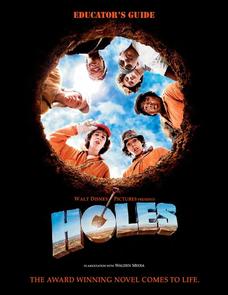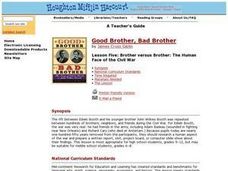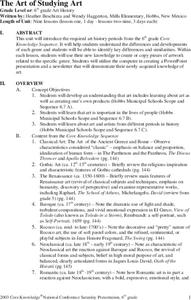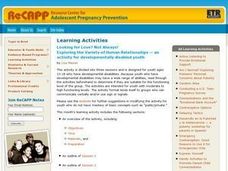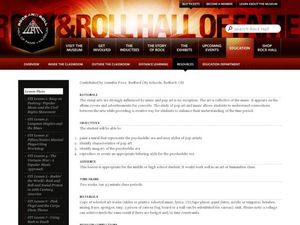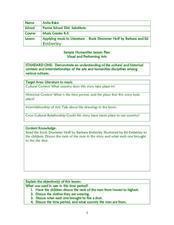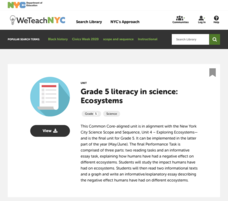Ohio Department of Education
A Glossary of Literary Terms
If you're tired of defining allusion, onomatopoeia, and satire for your language arts students, hand out a complete list of literary devices to keep the terms straight. Each term includes a definition that is easy to understand and...
Curated OER
Educator's Guide: Holes
You'll be a star at your next grade level meeting with an educational unit on Louis Sachar's Holes. Based on both the novel and film, the lessons include applications to language arts with character studies and movie reviews; social...
Curated OER
Art and Culture
Learners compare and contrast the ways in which human figures are portrayed in rock art made by ancient Native American artists and in the drawings and paintings of historic European and American artists. They use images to identify...
Curated OER
Proportion of the Human Form
Students discover proportions of the Human Body. In this anatomy lesson, students create replicas of the Human body using nothing but paper and glue. Students share their creations with the entire class.
Curated OER
The Fight for Human Rights
Students explore the concept of human rights by developing and defending their own 'Bills of Human Rights' and by writing a reflective essay that compares their notions of human rights and the protection of them.
EngageNY
Grade 9 ELA Module 2, Unit 3, Lesson 5
After rereading the full text of Walter Mosley's essay "True Crime," groups complete an evidence collection tool worksheet, and then class members independently draft a multi-paragraph, evidence-based response that identifies how Mosley...
Curated OER
Human Rights Day
In this Human Rights Day worksheet, students complete activities such as reading a passage, phrase matching, fill in the blanks, correct words, multiple choice, spelling, sequencing, scrambled sentences, writing questions, survey, and...
Curated OER
Brother versus Brother: The Human Face of the Civil War
Students research a human aspect of the Civil War and prepare a written report, skit, project board, or computer slide-show about their findings. They focus on how the war affected families who had members on opposing sides of the conflict.
Curated OER
Humans and the Natural World Poetically
Students read poetry for gist and find images to create a visual narrative. For this poetry lesson, students read Green Lane and Flies and Nettles to examine the relationship between humanity and the nature. Students reflect...
Curated OER
For the Well-being of Our Citizens Lesson 2: Poverty And Human Rights
Students investigate the definitions of poverty and impoverishment. They design a poster that show the Articles of the Universal Declaration of Human Rights that are violated by poverty. They write an article for the school newspaper...
Curated OER
The Art of Studying Art
Students explain the value of different genres of art. In this art lesson, students describe the differences in various genres of art and make comparisons between them. Students choose an art genre and create an original work of art...
Curated OER
Overcoming Censorship Through Art
Students examine and discuss government-imposed censorship of art and artists' methods for counteracting censorship. They view censored artwork, write a persuasive essay, and create an art piece.
Curated OER
Looking for Love? Not Always! Exploring Human Relationships
Students research psychology by examining real life situations. For this human relationships lesson, students discuss the importance of respect among two people in a romantic relationship. Students examine images of people in...
Curated OER
The Holocaust in Art, Photography and Writing
Students explore paintings, photographs and writings about the Holocaust using the internet. Researching the various websites, they will discover different human experiences of Holocaust victims. After researching, students write about...
Curated OER
The Invisible People: American Art and Literature Represents the Marginalized and Disenfranchised
Students view various pieces of art and sculptures which demonstrates people who are marginalized and invisible. While viewing the art, they are read excerpts of different pieces of literature in which they determine why the author or...
Curated OER
Art and Propaganda
Students examine the types of propaganda used throughout World War II. In groups, they view examples of different posters and artwork used to identify the human emotions the government was trying to appeal through. They develop their...
Curated OER
The Human Body: A Life-Size Model On Paper
Students create a life-size paper model of the human body. They identify the major organs and state their fuction. They complete a quiz to end the lesson.
Curated OER
Visual Art and Music
Students examine how pop art compliments music. In this arts lesson plan, students explore the elements of pop art and replicate those elements in their own piece of art.
Curated OER
Variation in Human Skin Color
Students explore factors that control variation in human skin color and the implications of this information for human society. They understand that skin color is no longer considered a credible scientific standard by which to classify...
Curated OER
Romanticism: Roots of Modernity
What were the changes in art during the Romantic period? The presentation starts by describing some of the common characteristics of Romanticism, and then several slides present examples from the era. Consider using this in an art or...
Equality and Human Rights Commission
Taking Action
The Universal Declaration of Human Rights passed in 1948 when the majority of members of the United Nations voted in favor of the resolution. Scholars use their knowledge of human rights to determine ways they personally can help promote...
Curated OER
Applying Music to Literature
Kids explore music, history, culture, and literature in a multi-faceted lesson plan. They discuss how both historical and cultural contexts shape music, art, and literature, and then apply these concepts as they engage in a listening...
University of Texas
Understanding Migration
Human migration—often the result of push and pull factors—sometimes has dramatic outcomes for both those leaving their homelands and the host countries. Using a variety of case studies, learners consider those issues. Then, by completing...
New York City Department of Education
Grade 5 Literacy in Science: Ecosytems
How do humans affect ecosystems? Learners read two articles and interpret a graph to develop essays on the human impact on ecosystems. They read about human impact on tigers and manatees as a basis for their overarching papers.

